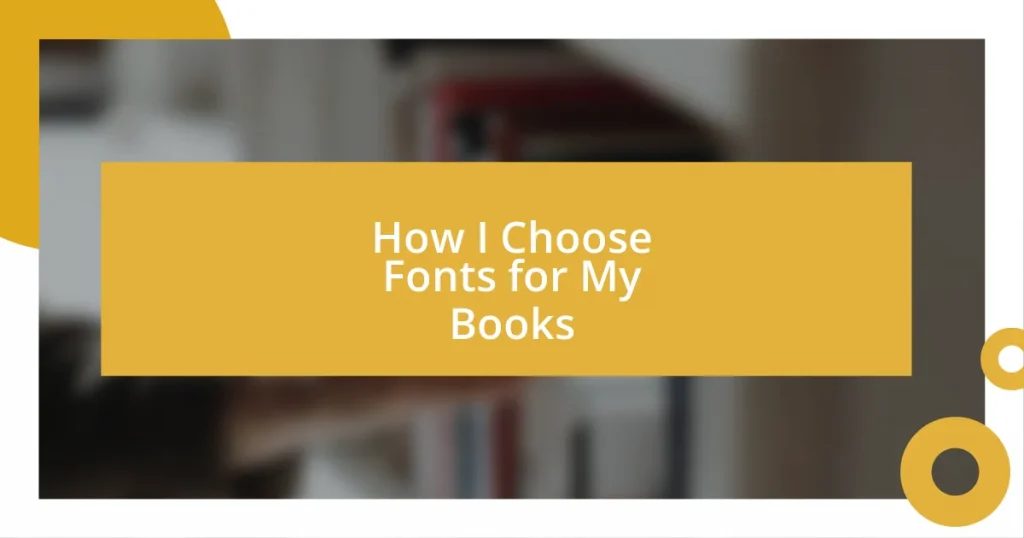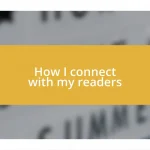Key takeaways:
- Font selection significantly impacts the reader’s emotional connection and perception of the text, enhancing or altering its message.
- Readability and legibility are crucial; aesthetic appeal must not compromise the reader’s ability to engage with the content effectively.
- Testing font choices within the layout and incorporating feedback is essential for ensuring the final selection resonates well with the target audience.

Understanding the importance of fonts
Fonts are more than just letters on a page; they shape the reader’s experience and influence their emotions. I once picked a font for a poetry collection that was both whimsical and elegant, and I noticed how it drew readers into the world I created. Have you ever felt a connection to a piece of writing because of its font? That’s the power we often overlook.
From my perspective, choosing the right font can significantly enhance the message of the text. For instance, when I used a bold, sans-serif font for a motivational genre, it gave a sense of urgency and strength. It made me wonder: How can a simple choice like font style change your entire perception of a message?
Emotional resonance also plays a crucial role in font selection. I recall a time I chose a delicate serif font for a memoir about loss. The softness of the characters seemed to cradle the words, inviting readers to connect with my emotions more deeply. Isn’t it fascinating how something as simple as a font can evoke such profound feelings?

Assessing genre and audience preferences
When I think about genre and audience preferences, I recognize that different types of writing call for different font styles. For example, while working on a young adult fantasy novel, I opted for a playful, slightly quirky font that complemented the adventurous spirit of the story. The feedback from my readers confirmed it—many felt that the font added to the allure of the magical world I was building. It’s a reminder that the right font can truly resonate with the expectations and tastes of your audience.
Here are some factors I consider when assessing genre and audience preferences:
- Genre Expectations: Each genre has its conventions. For example, classic literature often uses traditional serif fonts, while modern thrillers might favor clean sans-serif styles.
- Target Audience: Understanding who your readers are is key. A font that appeals to teenagers might feel entirely out of place for a historical non-fiction audience.
- Mood and Tone: The emotional weight of the content should be mirrored in the font choice. A whimsical font suits a lighthearted romance, whereas a more straightforward font may be better for serious topics.
- Readability: Ultimately, clarity is essential. Ensuring your audience can read and engage with the text should always be a priority.

Evaluating readability and legibility
When I evaluate readability and legibility, I always think about how easily my audience can engage with the text. For example, I once chose a beautiful script font for a short story, but I quickly realized that while it looked stunning, many readers struggled to decipher it. This experience taught me that aesthetic appeal isn’t everything; if readers find it hard to read, they might lose interest altogether.
Legibility often comes down to how well each letter stands out from the others, particularly in different sizes. I typically avoid overly ornate fonts for body text; instead, I lean toward clean and straightforward choices, especially for longer works. When I used a highly stylized font in a non-fiction piece, feedback indicated that readers had to squint to grasp important concepts. That pushed me to reconsider my approach and focus on clarity.
I also pay attention to line spacing and letter spacing, as these aspects can significantly impact the reading experience. For instance, when I adjusted the tracking of a font in my latest novel, I felt a noticeable difference—readers reported an easier flow and greater understanding. It’s intriguing how small adjustments like these can elevate the overall readability of my work, isn’t it?
| Font Style | Readability |
|---|---|
| Serif Fonts | High readability in print; traditional feel. |
| Sans-Serif Fonts | Very legible on screens; modern appearance. |
| Script Fonts | Low readability; best used sparingly. |
| Monospace Fonts | Good for technical content; consistent spacing. |

Exploring font pairings and hierarchy
When I choose fonts for my books, the idea of pairing different styles excites me. I often start with a primary font for the body text, usually something that’s easy to read, and then I select a contrasting font for headings. For example, in my last project, I paired a classic serif font with a bold sans-serif for chapter titles. The combination not only maintained a hierarchy but also created a visual rhythm that guided readers through the narrative effortlessly. It’s a bit like choosing the right ingredients for a recipe; the right contrast can make flavors pop.
Hierarchy in font choices also plays a huge role in how the content is perceived. I remember a time when I experimented with varying weights and sizes to emphasize sections in my writing. It was enlightening to notice how readers instinctively focused on the bolder headings, clearly understanding the organization of the content. There’s something powerful about visual cues that can make complex information feel more digestible. If readers aren’t engaged by the format, will they truly absorb the message?
My experiences have shown me that font pairings can evoke emotions too. A whimsical font paired with a more serious one creates a captivating tension, igniting curiosity about the deeper themes within the story. When I first paired a delicate script for personal quotes with a sturdy, modern font for the narrative, I was surprised at the emotional response it garnered. It made readers pause and reflect more deeply. Isn’t it fascinating how something as simple as a font can influence a reader’s emotional journey through the text?

Testing font choices in layout
Once I finalized my font choices, I began the actual testing process in the layout stage. I recall a time when I used a font that seemed perfect in theory. However, once I placed it in my layout, it felt crowded and overwhelming. I quickly realized that testing in the context of the page is essential—something that looks good in isolation might not have the same impact in actual use. It’s a lesson I won’t forget; I now make it a point to print out samples to see how they interact on a physical page.
Another thing I do is utilize mockups in various formats. For instance, when I was working on a project aimed at middle-grade readers, I created digital mockups of pages with different font pairings. Experimenting with a quirky font for chapter openings, I noticed how the children responded positively to the playful vibe, which was your instinct but also backed by observation. Seeing their excitement transformed my layout choices, reminding me that my audience’s reactions should truly guide my decisions.
Ultimately, I’ve learned the importance of feedback during the testing phase. I often share different layout options with fellow writers or readers in my circle. Not long ago, I gathered a small group to critique some layouts with contrasting fonts. Their insights opened my eyes to the subtleties I might have missed on my own, like how certain fonts can evoke warmth or distance. Have you ever experienced a shift in your work just by listening to others? For me, it was a transformative moment that reinforced the collaborative nature of the creative process.

Finalizing font selection for publication
Finalizing the right font selection for publication is a thrilling yet meticulous process for me. I vividly remember the moment I settled on a font for my debut novel. After numerous drafts and countless adjustments, I chose a sleek, modern sans-serif that felt just right. Seeing it on the page gave me an exhilarating rush, almost like walking into a familiar yet inviting space. Isn’t it amazing how a simple change can evoke such strong feelings?
Through every revision cycle, I pay attention to how the selected font communicates my story’s tone. During the final selection, I analyzed how different fonts affected the imagery in my mind. For instance, I once replaced a basic serif font with a slightly eccentric one for a fantasy piece, and it transformed the experience entirely. The new font added a layer of whimsy, drawing readers deeper into the enchanted world I created. How can a single choice, like selecting a font, change the reader’s perception so dramatically?
I also find it invaluable to consider the logistics of font legibility in the final selection. On one occasion, I received feedback that my chosen font was a tad small, making it hard to read during long reading sessions. After some soul-searching, I opted for a size up, acknowledging that reader comfort should take precedence over aesthetics. I believe it’s crucial to blend beauty with functionality because, in the end, if the reader struggles with the text, the story might get lost. Have you ever had to weigh aesthetics against clarity? It’s always a balance, but getting it right feels incredibly rewarding.















